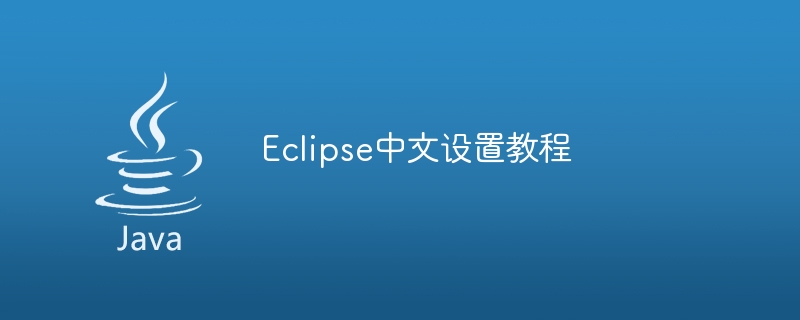Home >Java >javaTutorial >Eclipse Chinese Settings Guide
Eclipse Chinese Settings Guide
- WBOYWBOYWBOYWBOYWBOYWBOYWBOYWBOYWBOYWBOYWBOYWBOYWBOriginal
- 2024-01-03 16:26:501836browse

Eclipse Chinese setting tutorial, specific code examples are required
Eclipse is a widely used development tool, which provides developers with a convenient coding environment and rich plug-in function. For beginners, using a development tool with English as the main language environment may cause some trouble. Therefore, this article will introduce how to set up the Chinese environment in Eclipse and provide specific code examples.
- Download Chinese language pack
Eclipse officially provides a Chinese language pack. We can download the corresponding language pack from the Eclipse official website. Open the "Eclipse Downloads" page, select the Eclipse version you are using, and select the corresponding language pack to download. - Install Chinese language pack
After the download is completed, open Eclipse. Select the "Eclipse Marketplace" option under the "Help" menu. In the pop-up dialog box, search for "Language Pack", find and select the corresponding Chinese language pack to install. - Set workspace encoding
In the Eclipse workspace, the default encoding method may be mainly English. In order to display and edit Chinese characters correctly, we need to modify the encoding method of the workspace.
Select "Window" -> "Preferences" in the menu bar. In the dialog box that opens, select "General" -> "Workspace". Select "UTF-8" as the default encoding method in the "Text file encoding" drop-down menu, and check "Apply".
- Modify editor encoding
In addition to setting the encoding method of the workspace, we also need to modify the encoding method of the Eclipse editor to ensure that Chinese characters are displayed and saved correctly.
Select "Window" -> "Preferences" in the menu bar. In the dialog box that opens, select "General" -> "Content Types" -> "Text" -> "Java Source File". Select "UTF-8" as the default encoding method in "Default encoding" on the right, and check "Apply".
- Import Chinese character encoding sample code
In order to verify whether our Chinese settings are successful, we can import a sample code containing Chinese characters, and then display and edit the code normally in Eclipse.
Create a new Java project in Eclipse. Create a new Java class under the project and name it "ChineseExample". Copy the following code into the class.
public class ChineseExample {
public static void main(String[] args) {
System.out.println("你好,世界!");
}
}Save and run the code. If Eclipse displays "Hello, world!" normally, it means that our Chinese setting has been successful.
Through the above steps, we successfully set Eclipse to the Chinese environment and verified the normal display and editing of Chinese characters.
Summary:
This article introduces how to set up the Chinese environment in Eclipse and provides specific code examples. By downloading the Chinese language pack, setting the encoding method of the workspace and editor, and using sample code with Chinese characters, we can ensure that Chinese development is normally used in Eclipse. I hope this article can provide some help to beginners and make it more convenient for them to use Eclipse for Chinese development.
The above is the detailed content of Eclipse Chinese Settings Guide. For more information, please follow other related articles on the PHP Chinese website!

